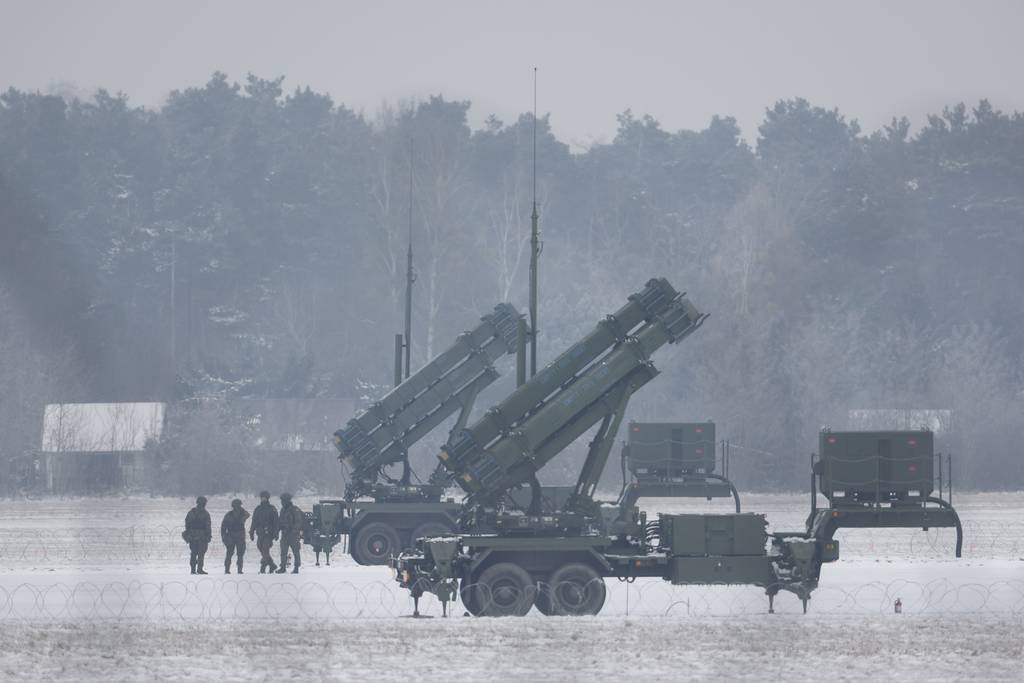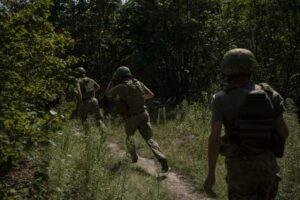
In December 1983, amid the heightened tensions of the “second Cold War,” U.S. Defense Secretary Caspar Weinberger and his West German counterpart, Manfred Wörner, agreed on a $3 billion program (worth more than $9 billion today) to boost NATO’s air defenses along the central front: the inner-German border with the Soviet-controlled eastern bloc. Four decades later, under the impression of Russia’s missile war against Ukraine, NATO leaders are wrestling once again with the strategic, operational and technical complexities of the air defense mission. They should revisit the 40-year-old U.S.-West German agreement for inspiration.
Throughout the first half of the Cold War, ground-based air defenses, or GBAD, were postured to support NATO’s Forward Defense strategy for Central Europe. Nike and Hawk surface-to-air missiles were deployed in a two-layer belt in West Germany. By the 1970s, after several improvement programs, both systems were exhausting their modernization potential, whereas the Soviet threat was steadily rising.
Moreover, as NATO turned toward Flexible Response — emphasizing graduated, primarily conventional options over massive nuclear retaliation — there was a desire for a non-nuclear replacement of Nike. But this required greater speed, range and maneuverability of the interceptors, a leap in sensor and guidance technology, as well as improvements to command, control and communication systems. Patriot was to provide this capability upgrade to U.S. and allied ground-based air defenses.
With defense budgets strained by other modernization priorities, Bonn and Washington struck an elaborate cost-sharing agreement to equip West Germany’s Bundeswehr with 36 Patriot fire units, ultimately boasting a total of 288 missile launchers with upward of 2,300 interceptors. Twelve fire units would be purchased by Bonn outright, and another 12 would be supplied by Washington. Twelve more would be lent to West Germany by the United States for an initial period of 10 years; all would be operated by approximately 2,000 Bundeswehr soldiers.
Bonn and Washington also agreed to procure several dozen Roland fire units — a Franco-German mobile short-range surface-to-air missile system — to protect U.S. and West German airfields in the country. These, too, would be operated by Bundeswehr troops. The Cold War ended before all Patriot systems arrived in now-reunified Germany.
In the post-Cold War period, costly air defense assets were a welcome target for cuts to military budgets across Europe. The U.S.-German-Italian Medium Extended Air Defense System development effort floundered; counter-UAV capabilities, too, received little attention. German Air Force officer Friederike Hartung’s recent study provides an excellent overview of the changing role of the Bundeswehr’s shrinking GBAD capability after 1990, barely able to keep running a dozen Patriot batteries and little else when Russia launched its full-scale invasion of Ukraine in February 2022. But gaps are even wider elsewhere in Europe.
Russia’s missile and drone attacks on military and civilian targets across Ukraine, and the shock of the war more broadly, produced a hurried response from European leaders to finally follow through on NATO plans to rebuild allied air defenses. By donating various systems, they helped Kyiv erect the densest air defense bubble on the continent. But this further strained European capabilities.
German Chancellor Olaf Scholz’s European Sky Shield Initiative, or ESSI, attempts to aggregate demand and leverage economies of scale for off-the-shelf GBAD systems, principally Patriot and the German-produced IRIS-T SLM. While 18 of Germany’s European partners signed up for the initiative to date, some criticized the choice of systems included (the French-Italian SAMP/T is not on the list, for example). Paris voiced concerns about the strategic implications of Berlin’s decision to purchase Israel’s Arrow 3 to protect against exo-atmospheric threats, worrying that it signals distrust in deterrence and could undermine strategic stability. Warsaw, meanwhile, decided years ago to modernize all layers of the Polish GBAD infrastructure. It saw no benefit from join the German-led initiative.
There are several paths to further broaden and deepen European cooperation on GBAD. The new Polish government outlined in its agenda for the first 100 days to follow through on its predecessor’s plan to acquire six Patriot batteries and to now also join ESSI. Poland’s desired Integrated Battle Command System configuration for its new Patriot batteries was previously considered a technical barrier to such a move, but other Europeans’ early expressions of interest in the capability could pave the way, thus reducing the price tag for Warsaw and expanding the initiative with a key Eastern European ally.
The 1983 agreement’s mechanism for U.S.-owned GBAD fire units to be operated by West German soldiers could serve as a template to move ESSI from a buyers club to a more integrated European pillar in NATO’s air and missile defense architecture. Instead of deploying their own troops to the eastern front, some Western European allies might find it easier to procure the hardware and have it then be operated by Estonian, Polish or Romanian personnel. This would further incentivize standardization and move European GBAD from interoperable to interchangeable.
Early European investments to expand industrial capacity for air defense systems are already benefiting Ukraine as well. A significant part of the growing production of interceptors for IRIS-T, for example, goes to Ukraine. The establishment of a tactical Patriot Advanced Capability-2 Guidance Enhanced Missile production facility in Germany will also help to replenish its stocks. But to get more urgently needed launchers and fire units there, the 1983 agreement’s lending model could be attractive for Ukraine’s partners by lowering the immediate financial burden compared to donations.
Today, NATO’s border with Russia is double the length of the Cold War’s inner-German dividing line. To extend an effective missile shield over the entirety of NATO’s European territory — or even only of front-line allies — would be both technically infeasible and prohibitively expensive. European NATO allies must complement efforts to strengthen GBAD with investments in deep-strike capabilities. But to advance cooperation in these areas, they do not need to reinvent the wheel. Their archives hold plenty inspiration.
Rafael Loss is the coordinator for pan-European data projects at the European Council on Foreign Relations’ Berlin office. He is an expert in German and European foreign and security policy, European integration, trans-Atlantic relations, and nuclear policy.
- SEO Powered Content & PR Distribution. Get Amplified Today.
- PlatoData.Network Vertical Generative Ai. Empower Yourself. Access Here.
- PlatoAiStream. Web3 Intelligence. Knowledge Amplified. Access Here.
- PlatoESG. Carbon, CleanTech, Energy, Environment, Solar, Waste Management. Access Here.
- PlatoHealth. Biotech and Clinical Trials Intelligence. Access Here.
- Source: https://www.defensenews.com/opinion/2023/12/27/whats-old-is-new-again-how-to-boost-natos-air-defenses-in-europe/
- :is
- :not
- $3
- $9 Billion
- $UP
- 000
- 10
- 100
- 12
- 1996
- 2022
- 300
- 400
- 7
- 70
- 9
- a
- Able
- About
- acquire
- across
- advance
- advanced
- After
- again
- against
- agenda
- aggregate
- ago
- agreed
- Agreement
- AIR
- Air Force
- All
- Ally
- along
- already
- also
- Amid
- an
- and
- Another
- approximately
- architecture
- archives
- ARE
- areas
- arrived
- AS
- Assets
- At
- Attacks
- attention
- attractive
- barrier
- batteries
- battery
- Battle
- BE
- before
- benefit
- benefiting
- berlin
- Billion
- bloc
- boasting
- boost
- border
- both
- broaden
- broadly
- bubble
- Budgets
- burden
- but
- buyers
- by
- capabilities
- capability
- Capacity
- central
- central europe
- changing
- choice
- club
- cold
- Communication
- communication systems
- compared
- complexities
- Concerns
- Configuration
- considered
- continent
- control
- conventional
- cooperation
- Coordinator
- costly
- could
- Council
- Counterpart
- country
- cuts
- data
- Date
- Days
- decades
- December
- decided
- decision
- Deepen
- Defense
- Defense Department
- Demand
- Department
- deployed
- deploying
- desire
- desired
- distrust
- do
- donating
- donations
- double
- dozen
- drone
- during
- Early
- easier
- eastern
- economies
- Economies of Scale
- Effective
- effort
- Elaborate
- element
- else
- elsewhere
- emergency
- emphasizing
- ended
- enhanced
- entirety
- estonian
- Europe
- European
- Even
- example
- excellent
- Exercise
- Expand
- expanding
- expensive
- expert
- expressions
- extend
- extended
- Facility
- February
- Finally
- financial
- Find
- Fire
- First
- follow
- For
- Force
- foreign
- Forward
- four
- from
- front
- front-line
- full-scale
- further
- gaps
- German
- Germany
- get
- Goes
- Government
- greater
- Growing
- guidance
- Half
- Hardware
- Have
- Hawk
- he
- heightened
- help
- helped
- his
- hold
- How
- How To
- HTML
- HTTPS
- image
- images
- immediate
- implications
- improvement
- improvements
- in
- incentivize
- included
- industrial
- initial
- Initiative
- Inspiration
- instead
- integrated
- integration
- interoperable
- invasion
- Investments
- IT
- ITS
- join
- jpg
- june
- Keep
- Key
- later
- launched
- layers
- leaders
- Leap
- lending
- Length
- Leverage
- light
- Line
- List
- little
- loss
- lowering
- massive
- Meanwhile
- mechanism
- medium
- might
- Military
- missiles
- Mission
- Mobile
- model
- modernization
- modernize
- more
- move
- must
- Need
- needed
- New
- NIKE
- no
- now
- nuclear
- of
- Office
- Officer
- Old
- on
- once
- only
- operated
- operational
- Options
- or
- Other
- outlined
- outright
- over
- overview
- own
- paris
- part
- partners
- paths
- pave
- period
- Personnel
- Pillar
- plan
- plans
- plato
- Plato Data Intelligence
- PlatoData
- Plenty
- policy
- Polish
- potential
- Prepare
- previously
- price
- primarily
- procure
- Produced
- Production
- Program
- Programs
- projects
- protect
- provide
- provides
- purchase
- purchased
- rand
- range
- received
- reducing
- reinvent
- relations
- replacement
- replenish
- required
- reservation
- response
- Reuters
- rising
- Roland
- Role
- Romanian
- running
- Russia
- s
- saw
- Scale
- secretary
- security
- sensor
- serve
- several
- Shield
- should
- signals
- signed
- significant
- SIX
- sky
- some
- soviet
- speed
- Stability
- standardization
- States
- steadily
- Stocks
- Strategic
- Strengthen
- such
- supplied
- support
- system
- Systems
- tactical
- TAG
- Target
- targets
- Technical
- technically
- Technology
- template
- tensions
- territory
- than
- that
- The
- The Initiative
- their
- then
- There.
- These
- they
- this
- threat
- threats
- Through
- Thus
- to
- today
- too
- Total
- toward
- transfer
- Turned
- u.s.
- Ukraine
- Ukraines
- Ultimately
- under
- Undermine
- unit
- United
- United States
- units
- upgrade
- upward
- various
- war
- Warsaw
- was
- washington
- Way..
- welcome
- WELL
- were
- West
- Western
- Wheel
- when
- whereas
- while
- wider
- will
- with
- worrying
- worth
- would
- years
- zephyrnet












